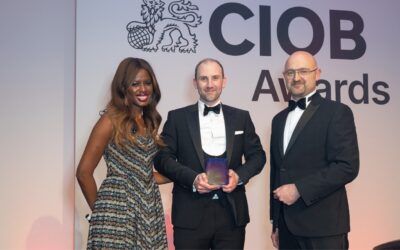The Chartered Institute of Building has announced the finalists for its prestigious annual awards.
News
The women flying the flag for construction
Three CMYA medallists give the lowdown on awards night, interviews and what they really think about the industry. Beating this year’s 79 other finalists to the trophy, Joseph’s achievement is all the more impressive given that it was his first project as a lead.
We’re going to hold our hands up here. Not many women enter CMYA. It’s a touchy subject and the symptom of a wider problem: the lack of women working in the industry at all
But several female construction managers have not only reached the CMYA finals but also won medals, scoring wide acclaim for their skills and leadership. Here we talk to three medallists about their experiences.
Sarah Morton made history in 2008 when she became the first woman to win a CMYA medal. Her project, phase three of Lancaster University’s Environment Centre for BAM, was tucked inside a live campus with a series of complex challenges. But Sarah’s silver was all the more remarkable because this had been her first job as a project manager.
“Writing the report for CMYA wasn’t so bad,” she remembers. “But it was daunting to do a presentation in front of some very experienced and distinguished people.”
She remembers the awards night for the widespread support she received not only from BAM colleagues but across the Ballroom at the Grosvenor House Hotel. “Lots of women that I didn’t know came up to me and said they were rooting from me, even though their husbands were up for an award,” she says.
Since winning, Sarah’s rise has been rapid. She quickly moved to bigger projects, before being promoted to preconstruction manager at BAM. Four months ago she joined Willmott Dixon as frameworks manager.
Julia Howard, formerly of Wates, took silver in 2013 for the Royal Hill School in Greenwich. This involved the refurbishment of an old building with an added steel frame extension, set deep in a residential area.
“I’d never entered CMYA before. It was a bizarre experience to sit in a room with four strangers, and hear the client verbalise exactly what they thought of me!” she says. “Although it was daunting, it gave me a major confidence boost. I also really enjoyed going back to see the school with the judges. We rarely get the opportunity to see buildings once we’ve handed them over.”
Now a project manager at Interserve, Julia believes that winning a CMYA medal was a good career move.
“This is a relatively small industry. Getting CMYA recognition definitely raises your profile. It’s great to have on your CV and is valued by employers.”
Leanne Broderick of John Sisk & Son is the most recent winner, having picked up a silver medal for Phase 2 of Rathbone Market in Canning Town in 2015.
This complex site had been Leanne’s first job as construction manager. One of her achievements was bringing in substantial value engineering at the start of the project, moving from a traditional concrete frame to a post-tensioned concrete frame. She also had to ensure that the structure connected with a fully occupied building with minimum disruption.
But despite her strong performance on site, it took some persuading for Leanne to enter CMYA at all.
“I’m the type of person who prefers to be working, rather than putting myself on show. I said I didn’t want to enter initially,” she remembers.
Having been persuaded by the client and employer, Leanne gamely underwent the gruelling hour-long interview with the judges.
“It was an intense experience,” she says. “But the judges were nice. They could see I was nervous and put me at my ease.”
After this ordeal, Leanne was elated to become a finalist and win a medal.
“I had an amazing night. It was great recognition of what I had achieved in my career to date. It was brilliant to spend time with people that I’ve worked closely with and who supported me in my career.”
All three women are passionate about promoting construction as a career choice and keen to encourage more women to enter the industry. The signs, they say, are promising.
“There are a lot more women in the industry than when I graduated 18 years ago,” says Julia. “But it’s a numbers game. There are still a disproportionately large proportion of male project managers.”
Sarah agrees, adding, “Women are less likely to follow the traditional route to construction manager. They’re more likely to take up other roles, such as working for clients, or moving into other areas such as design.”
She anticipates that new roles emerging from BIM and collaborative working will bring more women into leadership roles. But she still recommends construction management as an excellent springboard into other types of work.
“My background in project delivery has helped every job I’ve done since. As a construction manager, you get a handle on most aspects of the project, whether it’s design, cost, programme or clients. All those skills will be of benefit, whatever you do next.”
Leanne adds: “This is not a job for the faint-hearted, and you have to be pretty thick-skinned at times. But I really enjoy the range of people that I deal with on a day to day basis, from the client to subcontractors to my own team.”
Julia agrees. “I try to communicate to everyone how exciting construction is. I’m currently working at TV studios in the South East of England and learning about broadcasting. But I’ve done sewage works and everything in between. I love the diversity of this job.”
Other Stories
Size no barrier for SME CMYA winners
Your Guide to Navigating the CIOB Awards Process
Insights and tips for aspiring construction managers.



